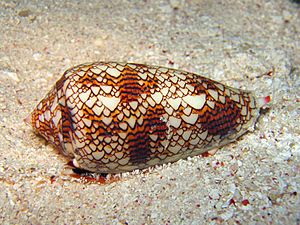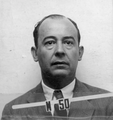Cellular automaton facts for kids
A cellular automaton is a model used in computer science and mathematics. The idea is to model a dynamic system by using a number of cells. Each cell has one of several possible states. With each "turn" or iteration the state of the current cell is determined by two things: its current state, and the states of the neighbouring cells.
A very famous example of a cellular automata is Conway's Game of Life. Stanislaw Ulam and John von Neumann first described cellular automata in the 1940s. Conway's Game of Life was first shown in the 1970s.
Contents
Biology
Some biological processes occur—or can be simulated—by cellular automata.
The patterns of certain seashells are generated by natural cellular automata. Examples can be seen in the genera Conus and Cymbiola. The pigment cells are in a narrow band along the shell's lip. Each cell secretes pigments according to the activating and inhibiting activity of its neighbor pigment cells, obeying a natural version of a mathematical rule. The cell band leaves the colored pattern on the shell as it grows slowly. For example, the widespread species Conus textile bears a pattern resembling Wolfram's rule 30 cellular automaton.
Plants regulate their intake and loss of gases via a cellular automaton mechanism. Each stoma on the leaf acts as a cell.
Moving wave patterns on the skin of cephalopods can be simulated with a two-state, two-dimensional cellular automata, each state corresponding to either an expanded or retracted chromatophore.
Threshold automata have been invented to simulate neurons, and complex behaviors such as recognition and learning can be simulated.
Fibroblasts are similar to cellular automata, as each fibroblast only interacts with its neighbors.
Related pages
Images for kids
-
Gosper's Glider Gun creating "gliders" in the cellular automaton Conway's Game of Life
-
A torus, a toroidal shape
-
John von Neumann, Los Alamos ID badge
See also
 In Spanish: Autómata celular para niños
In Spanish: Autómata celular para niños









